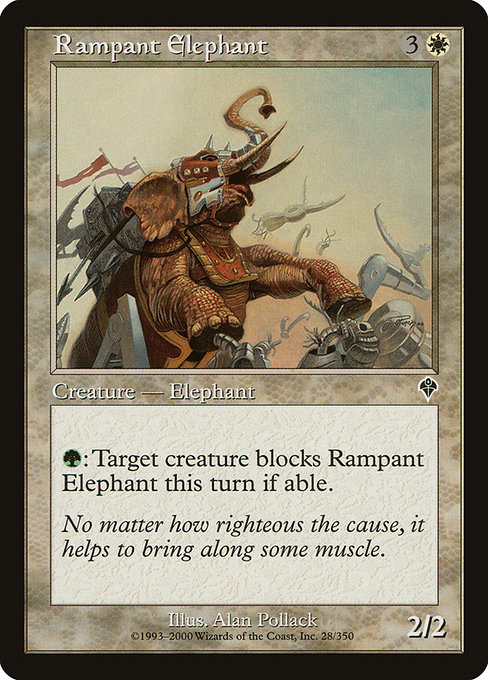
Image courtesy of Scryfall.com
Finding the Ideal Curve for Rampant Elephant Aggro
Rampant Elephant isn’t just a bulk 4-mana body; it’s a tempo trapdoor ready to swing open the moment green mana joins white in your mana base. This classic Invasion-era creature costs {3}{W}, a solid four-mana commitment that asks you to build a thoughtful early game so its square-jawed power can smash through on schedule. Its ability—
{G}: Target creature blocks this creature this turn if able.—pulls a neat trick: you can manipulate combat to force a specific block, buying you the time and space to set up bigger turns or push through incremental damage with a pump spell. In practice, Rampant Elephant thrives in white-green shells that value efficient early pressure and a little green flexibility to enable the block-forcing moment. The card’s flavor text—“No matter how righteous the cause, it helps to bring along some muscle.”—lands perfectly when you see a well-timed G activation turn a potential stalemate into a clean blow. 🧙♂️⚔️
From a design perspective, Rampant Elephant embodies the sweet spot of 1990s/2000s MTG: accessible to new players (a common from Invasion), yet with a surprising punch when paired with combat tricks. The white aura of direct offense, flavored with a green twist, invites a curious line of play where you dictate blocks and then capitalize with pump or follow-up threats. This is where the idea of a perfect curve becomes meaningful: you want your four-mana elephant to hit as part of a coherent sequence, not as a lonely beater that sits in your hand while you scramble to refill your board. 🧩💎
Curve concept: three anchors and a late-game hammer
To maximize Rampant Elephant’s potential, aim for a curve that creates consistent pressure and a clear path to victory once the elephant enters the battlefield. Here are practical ideas that align with Rampant Elephant’s chassis:
- Turn 1-2 pressure: Start with a low-cost white threat and ensure you have a green source in play by turn 2 or 3. The objective is to force your opponent to respond early, so Rampant Elephant arrives with a clear runway for combat tricks or a follow-up attacker. 🧙♂️
- Turn 3-4 setup: Establish multiple threats or a buff in hand. While Rampant Elephant’s casting cost is four, you want the battlefield to be crowded enough that the elephant’s attack feels inevitable—every extra body or pump spell makes the forced-block step more potent. 💪
- Turn 4: Rampant Elephant drops: The elephant lands as a 2/2 on its own, but its real value comes from the green activation that compels a block. If you’ve lined up a pump spell or an anthem effect, you can convert that forced block into a lethal result. ⚡
- Turn 5+: finishers and synergy: Follow with additional attackers or a second pump to push through final points of damage. The elephant’s presence often creates a window for politicking with your board—your opponent’s best blocker may swing and fall to a well-timed buff, sealing the game. 🎯
Strategic interactions: what to watch for
Leverage Rampant Elephant with care. Its activated ability is a resource, not a forced-win button—so you’ll want to protect it with white removal or early blockers that you can push through with a pump. A well-timed Giant Growth or a temporary aura can turn a single attack into a lethal sequence, especially if you’ve also prepared a second threat to keep pressure up. The green activation invites you to design around mana sources—forests, dual lands, or other splash possibilities—that keep the green open when you need to force that block. 🧭
Be mindful of mass removal and removal-heavy boards. A four-mana body requires tempo support; if your opponent stabilizes, Rampant Elephant can feel one-note. But when your deck threads in well-timed buffs and maintains pressure on successive turns, that single block-forcing moment can become the catalyst for a game-wide swing. The elephant’s resilience is less about raw stats and more about the calculated chaos you create in combat math. 🔒
Flavor, art, and a little nostalgia
Alan Pollack’s illustration brings Rampant Elephant to life with a sense of unstoppable momentum—the kind of visceral image that makes you grin when you slide the card across the battlefield. The flavor text reinforces the practical vibe of the card: sometimes muscle is the best policy, especially when you’re trying to punch through a stubborn defense. The Invasion set’s art direction has a distinctive vibe, blending timeless fantasy with a practical playbook that still resonates with players who love to optimize curves and tempo. 🎨
For collectors, Rampant Elephant remains a nostalgic staple that’s approachable for new players and a respectable budget pick for veterans. In today’s market, a nonfoil Rampant Elephant sits at modest value, while foils command a premium—proof that iconic, straightforward creatures from classic eras hold durable appeal even when their prices aren’t sky-high. The joy is in the curve and the craftsman-like planning that goes into maximizing its impact. 🧠🔥
On a desk or kitchen table where you’re laying out the day’s plan or drafting with friends, a sturdy display stand can help you keep your cards upright and visible—perfect for sessions that hinge on a single perfect combat step. If you’re in the market for something practical and stylish, consider a Phone Stand Desk Decor Travel Smartphone Display Stand to complement your gaming space. It’s a tasteful, compact piece that doesn’t intrude on your table chaos while you count damage and plan your next move. You can grab one here: Phone Stand Desk Decor Travel Smartphone Display Stand. 🧙♂️